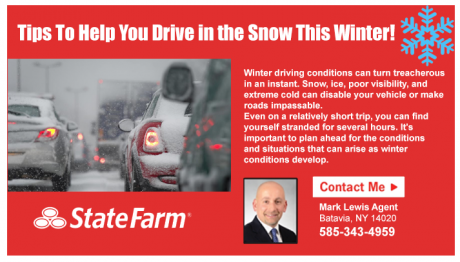Sponsored Post: Mark Lewis Agency/State Farm - Winter driving tips
Prepare Your Vehicle for Winter: The best time to get ready for winter is before the first storm of the season. Some items to check and talk to your mechanic about include:
- Test the battery strength.
- Inspect the exhaust system and the air, fuel, and emission filters.
- Check the cooling system, windshield wiper and antifreeze fluid levels, and change the oil.
- Make sure hoses and fan belts and all components are working properly.
- Consider changing the spark plugs.
- Check the tire pressure, tread life and consider installing winter tires.
- Locate the spare tire, jack, and ice scrapper.
- Inspect your wiper blades to make sure they're functional and in good condition.
Some Simple Winter Driving Tips: Winter driving has its own set of challenges from the moment you start your vehicle. Here are some useful winter driving suggestions:
- Never warm up your vehicle in a closed garage. This could lead to carbon monoxide problems.
- Keep your gas tank at least half full to prevent gas line freeze-up.
- Make sure your exhaust pipe is not clogged with mud or snow.
- Don't use cruise control on icy roads.
- Allow more time for braking when visibility is poor.
- Stay calm if you start to skid.
Commercial vehicle drivers should exhibit caution when driving in winter conditions. If your vehicle is large, like a truck, it needs more time to stop in ideal conditions, so snow and icy conditions magnify the challenge. Take care to continue safe practices when sharing the road in winter conditions.
Carry a Winter Driving Kit: Winter weather could leave you stuck in the snow, but the following items in your winter driving kit might help you get back on the road and on your way:
- Small folding shovel
- Tow and tire chains
- Basic tool kit
- Bag of road salt or cat litter
- Flares, battery powered flashlights and extra batteries
- Extra windshield wiper fluid and antifreeze
- Jumper cables to start your car if your battery dies
Pack a Winter Survival Kit: In case you're marooned in your car, truck or SUV, you might want to keep a small winter survival kit on hand. Some useful items include:
- A first-aid kit
- Cell phone charger
- Ice scraper and brush
- Blankets, warm clothing and other cold weather gear to protect against hypothermia
- Drinking water, and high-energy, nonperishable foods
Snow Safety Tips if You Become Stranded in the Winter: Few people like driving through a snow storm, and most heed warnings to stay off the roads when a storm is bearing down. But even the best-prepared and expert drivers can get stuck. If it happens to you, here are some important reminders:
Be prepared. While the best first step is prevention, some storms come on quickly. If you do get stranded, keeping a few essentials, noted above, in your car can help keep you comfortable while you wait.
Stay inside. If possible, pull off the highway and turn your hazard lights on or tie something bright to your car’s antenna to signal that you need help. Then wait inside your car until help arrives to avoid exposure to frostbite and prevent hypothermia.
Call 9-1-1. If you have a charged phone and reception, call for help and describe your location as best you can.
Clear the tailpipe. Make sure there’s no snow covering your tailpipe in order to prevent carbon monoxide buildup inside the car. Check the tailpipe periodically to ensure that fresh snow isn’t blocking it, always watching for oncoming traffic before exiting your vehicle.
Keep moving. Staying active inside your car will help you keep warm. Clap your hands and tap your toes to keep your circulation moving and prevent frostbite but avoid overexertion and sweating.
Drink fluids. Dehydration can make you more susceptible to the effects of cold. If there’s no drinking water inside your car, melt some snow inside a bag or other makeshift cup to stay hydrated.
Conserve your vehicle's battery. Use lights, heat, and radio sparingly.
Run your engine. Provided you have enough gas in your tank, run the engine for about 10 minutes every hour to keep the car warm. Turn on interior lights when your engine is on so you can be seen inside your car. Open a downwind window slightly for ventilation and clear snow from the exhaust pipe to prevent carbon monoxide poisoning.
Don’t overexert yourself. Cold weather puts your heart under added stress. If you’re not used to exercise, shoveling snow or pushing a car could put you at risk of a heart attack.
Stay safe and warm this winter by learning more about preparation for and recovery from winter storms with State Farm®


